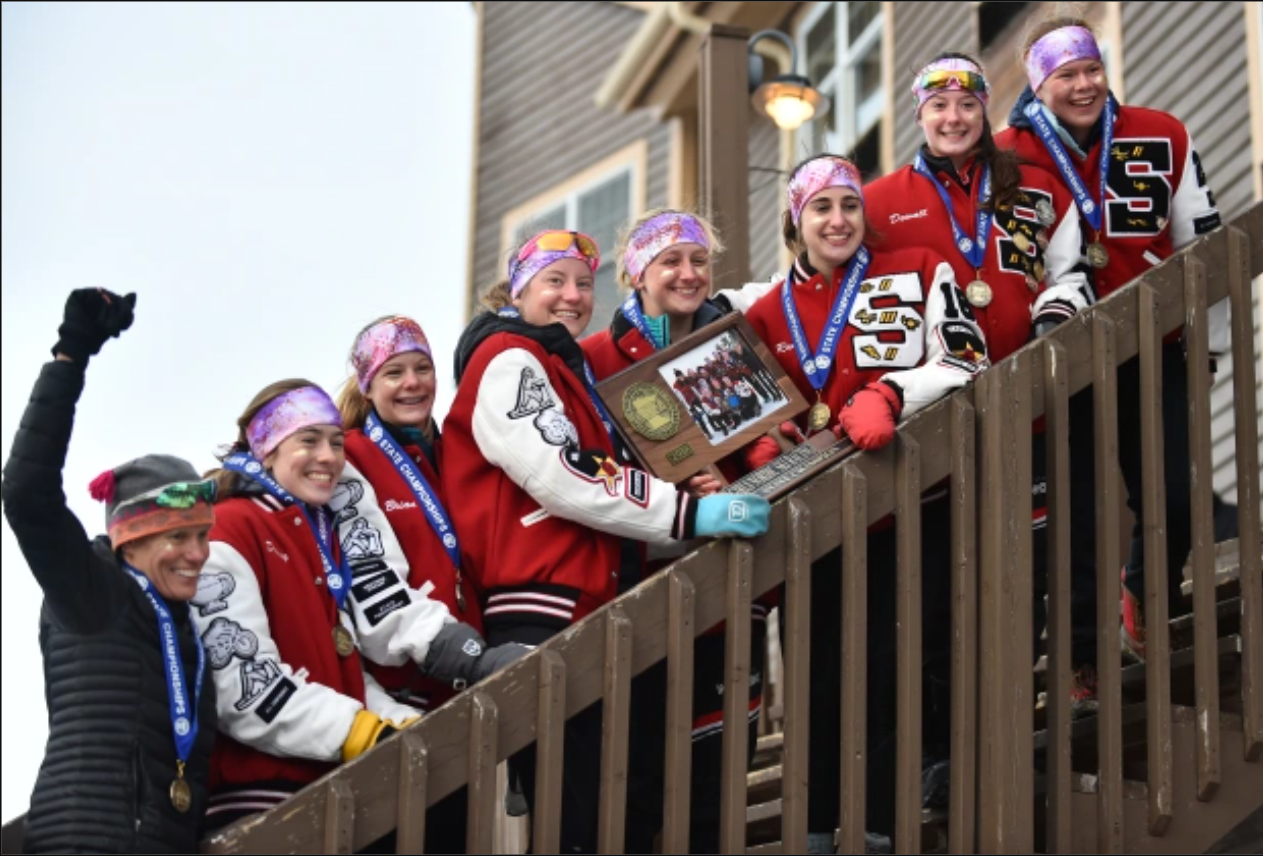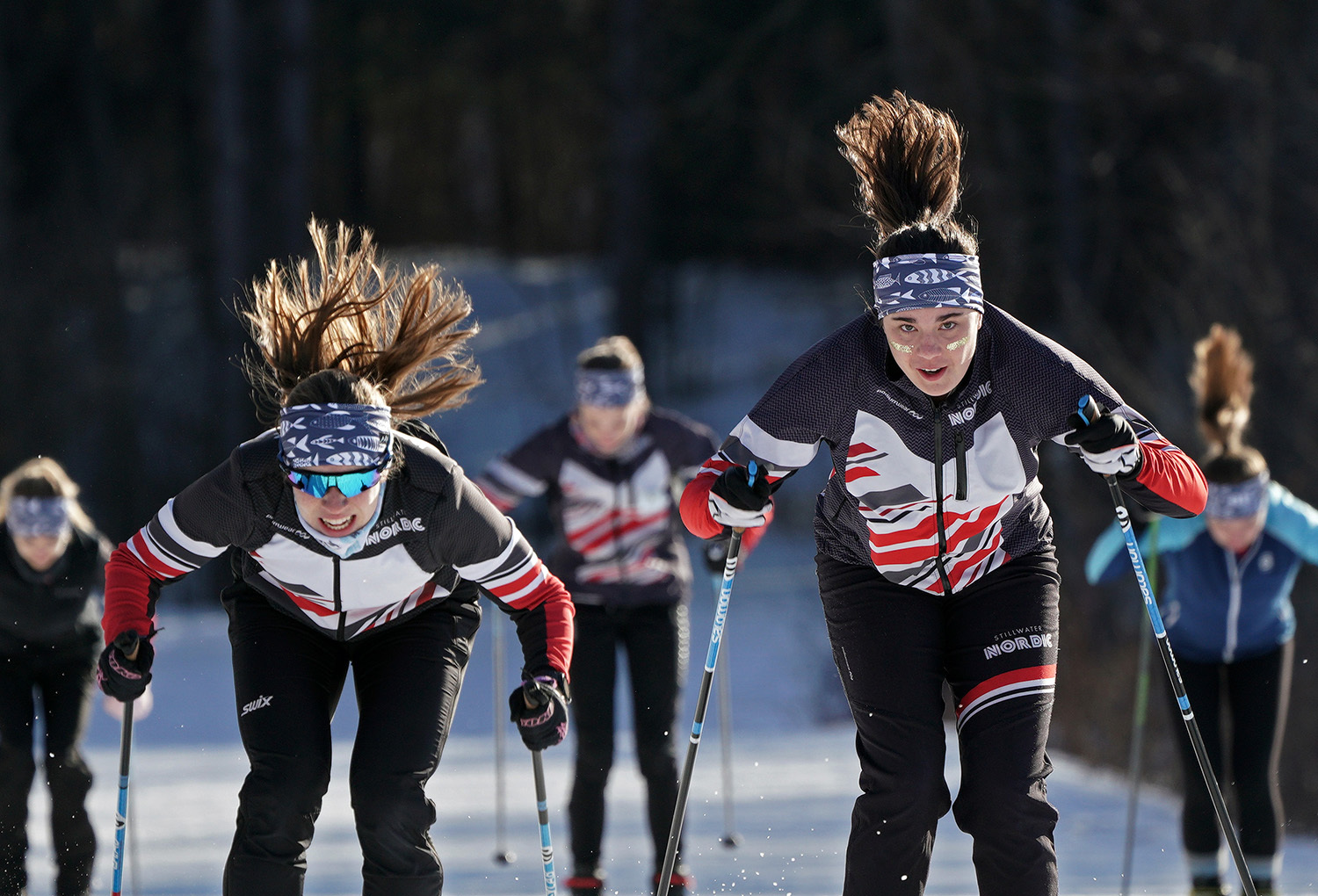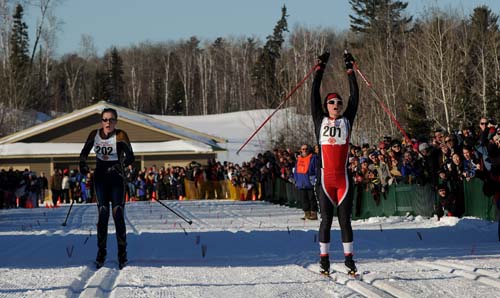
It was, “a race people still talk about,” said long-time Stillwater Area High School Coach Bill Simpson when FasterSkier interviewed him in February.
Distinctive red and white letterman jackets looked on from the stadium, medals clanging from the giant “S” insignias in the cold Iron Range wind. Giant’s Ridge, just outside of Biwabik, looked like the Hoosiers Field House if the janitor had forgotten to turn the heat on. A pairing of two future stars of the sport, Annie Hart and Jessie Diggins, sprinted to the finish of the Minnesota State High School State Nordic Ski Meet side-by-side. Diggins gained an edge, and her teammates joined one-by-one behind as the result became clear and the jubilation began. The Stillwater Ponies won the Minnesota High School State Nordic Ski Championships for the ninth time in program history, the most of any Girl’s program in Minnesota State Meet history.
Thirteen years on from her State Meet win, Jessie Diggins became the first American to win an individual World Championship in cross-country skiing. In the wave of adulation from the traditional European skiing world that followed, observers honed in on the two defining characteristics that Diggins has made her signature approach to skiing: 1) a complete focus on the success of her team and 2) her ability to push deeper than any other athlete in the sport. Or, as US Ski Team Program Director Chris Grover characterized it, the recognition that 1) “[The Americans are] a team having fun and enjoying the process” and 2) the “[other side], you see [Jessie] suffering. You see the tempo, pushing so, so hard.”
For Diggins, how she pushes and who she pushes for have been connected in her skiing from the beginning. The characteristics that led to an American landing on top of a World Championship podium were forged in an arena unique to American skiing—Minnesota high school skiing, with its over two-thousand yearly participants.
In a pre-World Championships press conference in February, Diggins said shooting for the team title of Minnesota State Champions with her Stillwater teammates “was the first time that I broke through that first level you push to in racing. I went, ‘Oh my God, there’s so much more in my body than I ever realized, and I can do this.’” For her, there was a traceable line from Giant’s Ridge to Planica, Slovenia, “having to figure out how to allow myself to care as much about my own races as I would care about my teams.” Still today, Diggins adds, “put my teammates at the finish line, and it all comes out.”
In high school skiing, said Bill Simpson, “the golden rule is not to turn anyone away.” In Stillwater, and in the High School circuit it races, there is an emphasis on accessibility and the absolute power of teamwork which serves as a grassroots source for what the wider-world of skiing is recognizing as American skiing’s signature qualities: the importance of teamwork, of celebrating the competitors as much as the competition itself, and of pursuing the experience of ski racing as much as the competition.
Today, high school circuits face the ever-evolving challenge of balancing tradition and that “golden rule” of accessibility, all while pushing forward with more skiers than ever.
Tradition in the North Star State
The Minnesota High School State Meet has been held every year since 1939, making it the oldest continuously running cross-country ski race in the United States. The tradition was a confluence of the state’s particular melting pot last century, when the Scandinavian diaspora saw many pioneers of the modern ski sport immigrate to the Midwest. For generations of Minnesotans (before the Vikings started playing Football), the popular way to pass a Sunday afternoon was at the foot of a ski jump. All it took was a Duluth boy named Billy Anderson approaching his physical education teacher to get a high school league formed, and from 1933 on, the Minnesota State Nordic Ski Meet has been held. Cross-country skiing, second in popularity to ski jumping as a nordic skiing discipline early on, was added permanently after 1938. For a full history of this nascent period, read Ryan Rogers’ extensively researched history of skiing in the state, Winter’s Children.
Bill Simpson started coaching the Stillwater Ponies in the mid-70s. Simpson, a teacher in Marine on St. Croix, was recruited to coach the first Stillwater High School Girls’ Team after Title IX was passed in 1972 and showed up to his first State Meet in 1975. “Even after Title IX, girls still weren’t allowed to ski jump in high school competition,” said Simpson. That ultimately led to the Nordic Ski State Meet becoming a cross-country only affair after 1977 and marked the start of the rapid development of the sport thereafter.
Simpson quickly went on a recruiting drive when the Girls team was added, grooming trails right around the Marine on St. Croix elementary school that allowed kids to stick around after school and hop on skis. Keeping the barrier to entry low paid off. When that group of Marine on St. Croix elementary schoolers reached Stillwater High School in the mid-80s, they would enjoy an unrivaled stretch of success, winning the State Team Championship every year from 1982-1987.
The star of those Stillwater Ponies teams was Kris Hansen. Hansen would win the State Meet individually in 1985 and 1986, which coincided with a rapid shift from classic to freestyle skiing, “In 1985, everyone was still classic skiing, with some marathon skate thrown-in. In 1986, everyone was skate skiing,” Hansen wrote to FasterSkier in February. Hansen was a sophomore and junior during her ’85 and ’86 triumphs, and contributed to the last of Stillwater’s mid-80s team title in 1987 while being ineligible to win the individual title after missing qualifying to compete at World Junior Championships. That unfortunate rule would lead to a fortunate lesson: “Competing that year taught me the absolute power of being part of a team,” Hansen said. “There was constant thinking on how to strengthen our collective performance and achieve that group goal [of a Team title].”
For Hansen, the lessons learned became the core of the philosophy around which she would structure the Stillwater team when she returned to coach it in the late 1990s. Her old coach, Bill Simpson, was still around, and fostering local kids’ love of skiing from an early age. Then and today, the Stillwater program fluctuates between 100-200 skiers on its roster at a time. It rivals the biggest club programs in the country, while drawing from a stretch of hilly bluffs and Twin Cities exurbs alongside the St. Croix river. It is one of the larger programs in Minnesota, but is also just one of 94 school districts in the state that sponsor a high school program. The sum total of high schoolers racing in Minnesota every year is over 2000. Programs stretch from small Iron Range towns to downtown Minneapolis, with skiers putting on skinny skis in just about every topography Minnesota has to offer. Golf courses, woodlots on the back forty, one of those 10,000 lakes or the shores of a one so big they called it Superior; you’re likely to find ski tracks on any of them when the winter hits. It’s what Hansen calls “the magic of the high school program: you don’t need to come from a ski family to learn and grow as a skier here.”
Accessibility, Community, Teamwork: the High School Skiing Ethos
In Stillwater, and other programs like it, the tradition of high school skiing forms a feedback loop that continues today. “We had a community where young people had mentors their own age,” Hansen said. “And then, the opportunity to become mentors for others. Everyone feels their value in a place like that.”
Hansen’s approach helped build another Stillwater Team Champion team in 2008, and then again in 2010, with Jessie Diggins leading both efforts. Her personal highlight as a coach, though, would come eight years later. “Both of my twins skied at the State Meet as team captains, Hansen remembered. “My daughter’s team won and my son’s team was runner-up. And then Jessie and Kikkan won their Gold; February 2018 is hard to beat.”
It was a moment of clairvoyance for what had powered US Skiing to an historic milestone. High school skiing is an outlier in skier development models across the world. It is a kind of inherited relic from when American culture intersected the Scandinavian diaspora early last century in the Midwest. But its key ethos is something that remained all the way through to Pyeongchang. A basis in community, a commitment to accessibility, and a unique emphasis on the power of team in an individual sport: high school skiing had been informing decades of US skiers, and now one of them, Jessie Diggins, had taken it, leaned in, and propelled herself and her teammates to the top of the sport. Hansen could celebrate on the terms by which she defines the sport of skiing: one member of her team stood atop an Olympic podium with a medal, another generation was learning simultaneously back in Minnesota. Her ski community was still growing, still pushing, still welcoming more young athletes to try skiing, and then emphasizing working together once they were on there.
Five years on from the Pyeongchang gold medal, Diggins is still forging new paths for American skiing, while her approach to the sport has become a grounding for an entirely new generation on a nation-wide scale. Aside from winning an individual World Championship in Planica, she also teamed up with Julia Kern to help win a bronze for the US in the Team Sprint, helping Kern become the first American athlete of the next generation of US skiers to win a World Championship medal. In a pre-race press conference, Diggins was as attentive to her teammates strengths as ever, emphasizing her trust and her admiration for Kern’s “fitness, her distance chops, the raw speed, the tactics, the confidence, and her ability to also just dig, all out, for the team. That above all, is what is really special about our team.”
The Challenges of Keeping “the Magic Power” Intact

For the country’s oldest ski circuit, change has always been a feature rather than a bug. Those changes have almost always included debates on how to keep the accessibility of high school skiing open, while preparing skiers to compete in the sport of cross-country skiing at its highest level. “There has always been a weird spot where the top athletes here are some of the top athletes in the country,” said Simpson. “There is something cool about that though, too; we have athletes in Norway one week, and then back at their Section race the next. How many high school sports is that happening in?” In the past, balancing a sport with an international outlook has meant cutting ski jumping from the Nordic ski program, adding classic skiing back into the sport after it was abandoned in the late 1980s, and adopting a pursuit format for the State Meet. Presently, though, the biggest challenges in keeping community-based Minnesota high school strong are the shifting demographics of the Gopher State’s communities, themselves.
“For a long time, there were new programs every few years, but that’s not so much the case anymore,” said Simpson. “And the schools in the [rural] northern part of the state are increasingly putting co-ops together” in order to try and keep their numbers on a similar scale to the Twin Cities schools, where participation in cross-country skiing has exploded during the pandemic. The trend highlights a long-rooted dynamic between more rural programs from the state’s varied rural landscapes and the Twin Cities metro area.
That rural-metro divide is also one that is increasingly colored by another distinct phenomenon: the rise of club skiing in the Midwest. Long a fixture of Western junior circuits, club skiing was a relatively small component of junior skiing in Minnesota, and in neighboring Wisconsin and Michigan, until a generation ago. Since then, big programs such as the Twin Cities’ Loppet Nordic Racing, which currently holds the title of Best Club in the country at Junior Nationals, have increasingly become home for high school athletes with a year-round focus on ski training, and from across a wide swath of communities that once trained in their own, distinct programs. “I worry about the club culture,” said Hansen. “For me, the feature of the high school program is that you don’t need to come from a ski family, and you don’t need to have a huge bank account to learn and grow as a skier and as a member of a team.” In contrast to the no-fee or modest fee structure most high school programs have traditionally had, club ski programs in the state can cost a family anywhere from hundreds to thousands of dollars in yearly registration fees (many do offer scholarships to offset costs for families). Many deliberations from the Minnesota High School Coaches’ Association over the past decade have allowed a hybrid model to emerge in the state, where athletes often race and belong to both a club and a high school program. “That is a tricky balancing act always” said Simpson, but also “One that makes the best out of the realities that people are willing to invest in skiing.”
Logistical challenges also loom large in the future of the high school circuit. “We’re a winter sport, and [in Minnesota] we’re losing winters with climate change,” said Simpson. “We’re increasingly competing for time on a limited number of man-made snow loops with every other team in the state.” For Stillwater, that means an hour-long drive to get on snow compared to being able to step out of the high school on groomed snow consistently when Simpson started. Man-made loops once used by Metro area schools exclusively in the early season are also increasingly becoming called upon for schools from beyond the Metro, and for more of the season, than ever before. Snowmaking efforts in Duluth have eased the congestion in recent years, but the chase for snow still requires “more time set aside to get to venues and is a prohibitive cost for schools looking to add the sport” explained Simpson.
A Great Race and a Grand Tradition Continues
“Year-to-year, thousands of kids [are] involved in high school skiing,” says Simpson. “If we can hold onto that number, and hold onto what has made high school skiing special, we’ll be doing ok.”
“I will always cherish my athletes coming together with their best performances and to see a community work so hard to achieve something together,” said Kris Hansen.
With an eye towards capturing that special essence of high school skiing, athletes, coaches, supporters, communities, and teams returned to Giant’s Ridge last February. It rained on day one before the sky cleared and a bout of brutal Minnesota winter cold swept over the glacial knolls and through the bare oaks and maples. The crowd that gathered had yet to watch Jessie Diggins stand atop a World Championship podium (that championship milestone would be achieved a few weeks later) but arrived knowing that what it would see was what they had seen on display from that champion, in this venue, that had radiated out through the sport of skiing over the past decade. The kids were here, and they would push for themselves, for their communities and, most importantly, for their teams.
This year, those values came fast, hard, and close into the Giant’s Ridge stadium. In the Girls’ race, results came down to a split second. In the Boys’ race, results were decided by even less. Zoe Devine, from the small Iron Range town of Ely, won the girls race over Duluth’s Lydia Kraker. Benon Brattebo, from the Twin Cities’ suburb Eden Prairie, outstretched Blaine’s Ben Lewis; their times both officially even, 26:00.9. Red and black suits flooded into the stadium to celebrate a team championship—this time belonging to Duluth East—with Stillwater taking second in the Girls’ competition.
The athletes had pushed hard for each other and had given it their all. Powerhouse programs that have long stood out in their nearly century-long existence etched their name into yet another year of lore. It was typical of Minnesota high school skiing, which only served to highlight how atypical it was. The letterman jackets, the familiar faces here year-after-year as athletes, then coaches, then parents, then just fans. It was a race that a decade from now, as one of the wise-old stalwarts of the whole spectacle, Bill Simpson, would put it, will prove to be one “people still talk about.” And that is as good a reassurance as any that high school skiing is a grand tradition, and a vital one too.

Ben Theyerl
Ben Theyerl was born into a family now three-generations into nordic ski racing in the US. He grew up skiing for Chippewa Valley Nordic in his native Eau Claire, Wisconsin, before spending four years racing for Colby College in Maine. He currently mixes writing and skiing while based out of Crested Butte, CO, where he coaches the best group of high schoolers one could hope to find.
